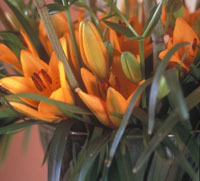The care information provided in this section represents the kind of practical advice is available for all the plants in this web site if you subscribe to the monthly customized newsletter Yardener’s Advisor.
 |
| ©Netherland Bulb Information Center |
In the spring when new shoots begin to appear, do not weed or rake the area, lest you damage these tender babies. While many of the Asiatic hybrids are bred sturdy enough to stand alone, it may be advisable to stake some of the very tall types to support the heavily flowering stems. After the flowers have bloomed, remove them to prevent them from going to seed. Cut the stalk just below the lowest flower. Leave the remaining stem and all its leaves to gradually wither and turn brown after it has collected nutrients for the bulb for next year.
Watering Lilies
Ideally, lilies should get 1 inch of water a week from rain or from your watering system. If your bulbs haven't gotten 1 inch of water during the week, check soil moisture under the mulch to see if you need to water. Lilies don't need much water while they're flowering, but water regularly later to encourage rooting and help the bulbs store up nutrients for next season. Use a soaker hose and avoid splashing the leaves, which encourages disease. If you can do your bulb planting just before a good soaking fall rain, you won't need to water. During hot, dry weather, water thoroughly once a week. For information on products see the file on Choosing Watering Equipment
Fertilizing Lilies
Like most bulbs, lilies do best when they are fed twice a year. Fertilize them in the early fall after the foliage has died back, and again in the spring just as they emerge from the ground. Sprinkle about a tablespoon of granular fertilizer (or "bulb food") per bulb, or a slight handful per clump, on the soil near them. Rain or watering will soak it in. Do not feed lilies just after flowering, when the bulbs can least use the nutrients--that just encourages disease.
Mulching and Weed Control
Mulching helps control weeds, conserves soil moisture, and keeps dirt from splashing up on the flowers. Spread leaf mold, chopped leaves, shredded bark, or other attractive organic material in a 1 or 2 inch layer on the soil around the plants. This will also protect the soil from heaving because of winter temperature fluctuations. Don't pile much more than that over your bulbs, or next spring the stems will have to travel too far to reach the light. Weeds that penetrate a mulch covering should be hand-picked; tools may damage lily roots. For more information see the file on Using Mulch
Propagating Lilies
New lily bulbs grow readily from the bases of the parent bulbs, and are a source of new plants. After 5 or 6 years, lily flowers become smaller and the plants may be weaker. This is usually a sign that the bulbs have become crowded into clumps and need to be divided. Dig the clumps after the foliage turns brown late in the summer. Gently lift the clumps, shake the soil off the roots, and carefully pry them apart. Discard any unhealthy looking bulbs and then replant the rest, spaced 12 inches apart. If planting is delayed, wrap the bulbs in a plastic bag of barely moist peat moss to keep the roots from drying out and store them in the refrigerator or other chilly place. (Unlike many other bulbs, those of lilies are never really dormant.) Asiatic hybrid lilies also grow easily from seed, but will not flower for 2 to 4 years.

